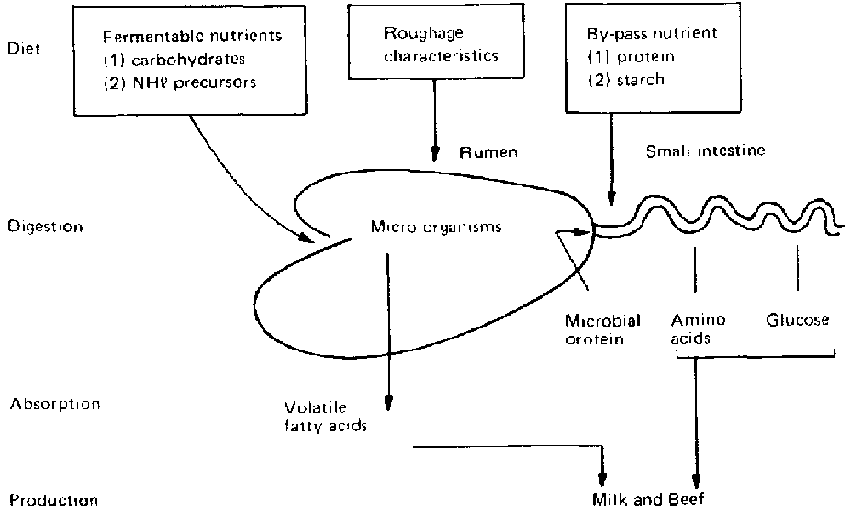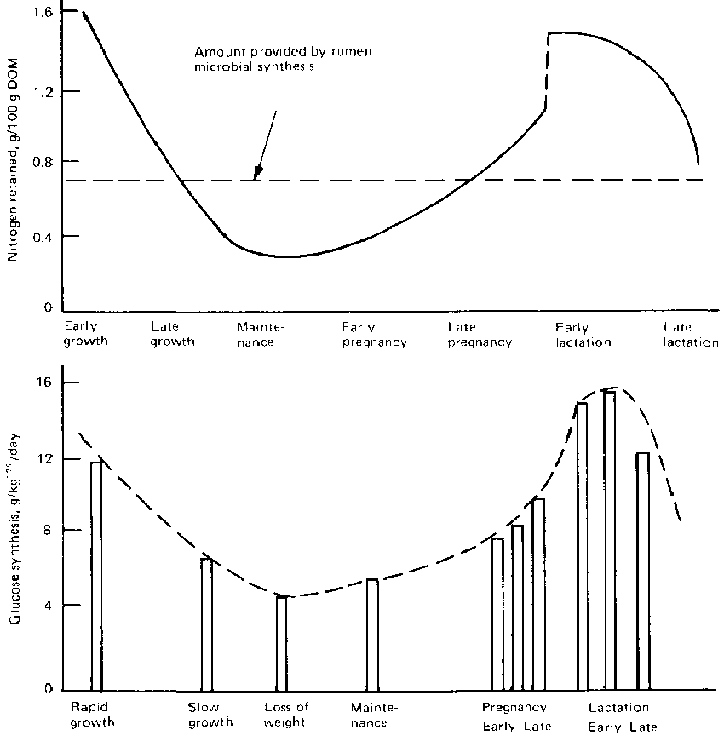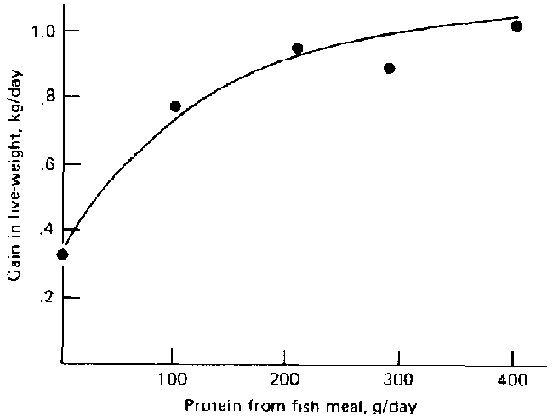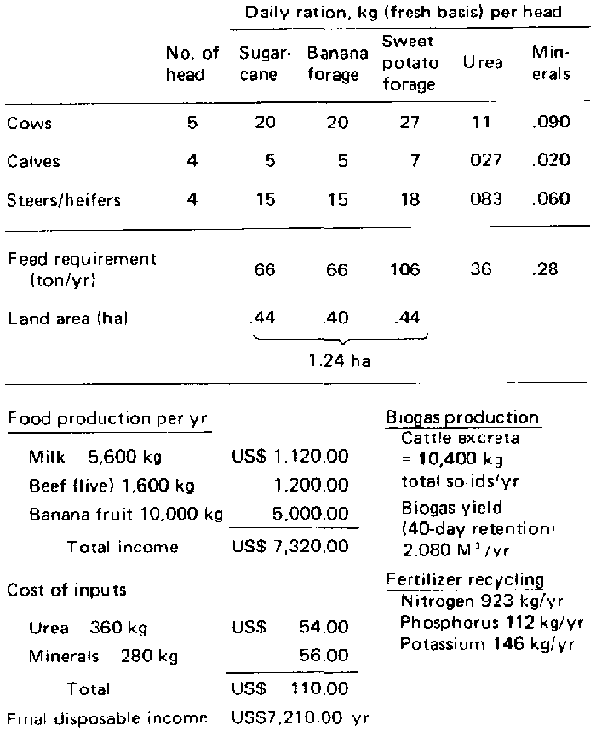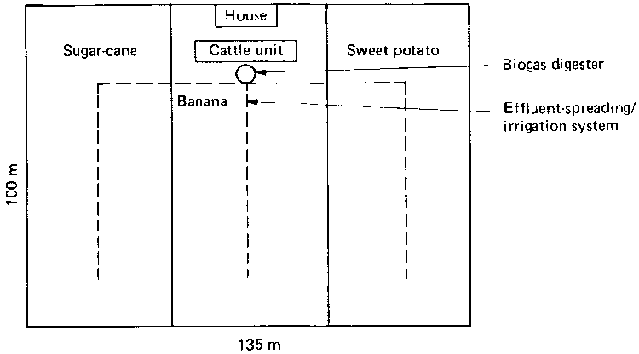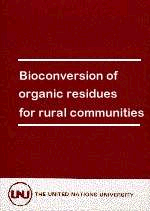
Bioconversion of Organic Residues for Rural Communities (UNU, 1979, 178 p.)
The role of ruminants in the bioconversion of tropical byproducts and wastes into food and fuel[edit | edit source]
T.R. Preston
Dominican Centre for Livestock Research with Sugar-Cane, CEAGANA, Santo Domingo, Dominican Republic, and School of Veterinary Medicine and Zootechnics, Merida, Yucatan, Mexico
Introduction[edit | edit source]
In many tropical countries, pressure on available land is increasing daily due to the high rate of population increase, bringing, as a consequence, increasing demands for food and the production of export crops to help the balance of payments. As a result, there is a competition for land use between traditional cattle production methods based on grazing, and arable agricultural land dedicated to the production of food crops and export crops.
In the light of these developments, it is becoming increasingly important in the tropics to integrate livestock with agriculture. One of the objectives of this paper is to show how animals, and specifically ruminants, can live and produce on the by-products and wastes of agricultural crops.
The advantages of this approach can be appreciated from a consideration of the potential benefits that can result from integration of livestock and crop production. These are:
- the recycling of animal wastes (manure) to produce biogas by anaerobic fermentation, and later the application of the residual, partially digested slurry as organic fertilizer for crop production;
- the saving in energy that will result from the recycling process, and the reduction in environmental contamination and health hazards;
- the possibility of being able to exploit fully the potential of the tropics for converting solar energy into biomass by means of the production of crops of high biological efficiency with multiple uses.
The possible integration of livestock and crop production encourages decisions to be made and action initiated in the following areas. In the first place, there is the opportunity for better planning in the selection of crops for growing in the tropics, the objective being to select those with double or multiple use characteristics; in other words, crops that have a capacity to produce food for human consumption and large quantities of by-products for animal feeding. On the other hand, the decision to integrate livestock and agriculture makes it imperative to expand, rapidly and widely, research and development into systems of animal production that will encourage the more efficient utilization of these by-products and wastes from crop production and agro-industries.
As an example of crop planning, one can take the existing situation in Central America, where there is a strong tradition of growing maize as a staple for human consumption. However, on the basis of the philosophy of integrating livestock with agriculture, maize is by no means the most appropriate crop, either in its capacity to produce grain and byproducts, or in its mode of growth in the tropics, since maize is susceptible to pests and also encourages land erosion in areas of heavy rainfall. Table 1 shows the considerable advantages that would be obtained by growing bananas instead of maize, with the objective of multiple use for animal and livestock needs. It would appear that the banana plant is capable of producing more energy for human consumption (as starch) and at the same time leaves behind in the form of by-products (the forage, trunk, and leaves) very large quantities of biomass that would be capable of supporting animal stocking rates similar to, or even in excess of, those achieved normally in specialized cattle production systems based on the use of pastures.
TABLE 1. Production of Primary Product (Starch) and By-products from Maize and Banana Crops
|
By-products Fresh weight (ton/ha) |
Dry weight (ton/ha) |
Digestibility (%) |
Digestible dry matter |
Primary product(starch) (ton/ha) | |
| Maize | |||||
| Average yield | 2.25 | 2.0 | 35 | 0.7 | 1.1 |
| Excellent yield | 12.0 | 11 0 | 35 | 3.8 | 5.6 |
| Banana | |||||
| Average yield | 162 | 13 | 70 | 9 | 3.2 |
| Excellent yield | 430 | 35 | 70 | 25 | 9.0 |
Nutritional limitations in the use of tropical by-products and waste[edit | edit source]
It is becoming commonplace to plead for the development of appropriate technology when we talk of the problems of developing countries and the transfer of technology from the advanced countries However, there is a strong argument in favour of this philosophy in the general field of the feeding of ruminant animals on tropical feeds and wastes.
The justification for this approach can be seen in the many results obtained in the feeding of tropical crops and byproducts to ruminant animals, where performance levels have usually fallen short of expectations in comparison with nutritional results obtained in temperate climates.
The majority of by-products and agricultural wastes of tropical origin are characterized by the following factors: a. The carbohydrate component consists of highly soluble elements (sugars) that have a high rate of degradability in the rumen. It also has elements of very low solubility (cell wall components) with low rates of degradation by rumen microorganisms. In particular, most tropical byproducts and wastes do not contain starch, which is an important component of most feeds fed to livestock in temperate zone countries. b. In addition, most tropical by-products and wastes contain low levels of both total nitrogen and true protein. The final effect arising from the combination of these two sets of characteristics is a low voluntary intake by the animal and this, in turn, leads to a low rate of productivity.
The nature of the carbohydrate fraction in tropical feeds, as described above, and the low nitrogen levels that necessitate incorporation of quite high levels of non-protein nitrogen, means that the digestion process in the animal must be principally by the route of fermentation by rumen micro-organisms. This is because the sugars are immediately fermented when they enter the rumen because of their solubility, and because the animal secretes no gastric enzymes capable of hydrolyzing cellulose and associated cell wall components. Obviously, non-protein nitrogen, too, can only be converted into protein by fermentation processes.
One would imagine that such a situation would correspond closely to the environmental niche for which ruminants were evolved. In fact, it has been found that when the nature of the ruminant's diet is such that it is obliged to pass through the rumen fermentation process, and the only "feeds" presented for digestion in the small intestine are the bodies of rumen micro-organisms, the voluntary intake of feed (by the animal) is abnormally low, and as a consequence the level of animal performance rarely exceeds maintenance.
When voluntary intake is low, rumen dilution, or turnover rate, is also low. This, in turn, reduces the rate and efficiency of microbial growth and, therefore, of microbial protein synthesis. Thus, with most tropical feeds and byproducts, we have a poor performance syndrome caused by low voluntary intake and low efficiency of rumen function.
Results of recent research have shown that three factors play determinant roles in such dietary situations. The most important factor is "by-pass" protein. This is protein of dietary origin that is not, or to only a small extent, degraded by the rumen micro-organisms and arrives intact at the duodenum, where it is digested by gastric enzymes to its component amino acids that are then absorbed. The value of such by-pass protein lies less in its role as a direct source of amino acids than in the effect that it has on over all voluntary intake and rumen function. Thus, the higher the amount of by-pass protein, the greater is voluntary intake. Furthermore, both rumen turnover rate and total flow-out of the rumen also increase; ipso facto, efficiency of rumen microbial protein synthesis is increased.
The second factor is the roughage characteristics of the diet. These presumably act through direct effects on rumen motility and rumen contractions, and/or by providing a superior "ecosystem" in the rumen. Evidence for the former is in the increase in intake and rate of animal growth when sugar-cane leaves, employed as the sole roughage in a liquid molasses diet, were chopped into large pieces instead of being ground finely (1). Substantiation for the improved "ecosystem" in the rumen are the observations that both intake and digestibility on a basal sugar-cane diet were improved when a highly digestible, but low-protein, roughage in the form of banana stalk was included in the diet (2).
The third factor is "by-pass" energy. The evidence here is less conclusive; however, there are sufficient observations to justify belief in the basic effect. Starch as a component of the dietary supplement, and glucose infused directly into the duodenum, have been the principal mechanisms used to effect the by-pass. It has been known for some time that some starch sources (e.g., maize) are not rapidly degraded by rumen micro-organisms, and that a considerable portion of the starch passes on to the duodenum (3). These observations were made on temperate zone, cereal-based diets and little practical importance was attached to the findings.
The digestion process in the ruminant, outlining the separate pathways for fermentable and by-pass nutrients, is shown in Figure 1. The quantities of by-pass nutrients required will depend upon the rate of productivity for the particular trait under consideration, whether this is growth of tissue, as in production of meat, or the secretion of milk.
Figure. 1. Simplified Version of Digestion in Ruminants Given Sugar/Cell Wall Carbohydrates and Non-protein N as the Basal Diet, Supplemented with By-pass Nutrients. Voluntary intake of the fermentable component of the diet is controlled by the amount of by-pass protein and by the roughage characteristics of the diet. By-pass starch appears to improve feed conversion.
Figure 2 shows how these requirements for by-pass nutrients are related to the particular stage of the production cycle of the animal. The neo-natal calf and the high-producing milk cow represent two stages in the production cycle when there is highest demand for by-pass nutrients. Modern systems of cattle production, as developed in the temperate zone countries, emphasize these requirements by the early weaning of the calf and by encouraging very high rates of lactation yield, and have led my colleagues and me to propose that in tropical countries, where by-pass nutrients are expensive, it is desirable to modify the management system so that both early weaning and high individual milk production are discouraged in favour of more moderate, less specialized approaches (e.g., 4, 5).
Figure. 2. Relationship between Stage of Production Cycle and Requirements for By-pass Nutrients. The top graph (E.R. Orskov, in H. Swan and D. Lewis, eds., Proceedings, 4th Conference of Nutrition Feed Manufacturers, University of Nottingham, Churchill, London, 1970) shows the requirements for amino acids expressed as total N retained in the body (9) per 100 9 of digestible organic matter consumed; the broken line is an estimate of the contribution from the rumen micro-organisms. The lower graph (from R.A. Leng, "Factors Affecting Net Protein Production by Rumen Microbiota," in T.M. Sutherland and R.A. Leng, eds., Review of Rural Science 11. From Plant to Animal Protein, University of New England: Armidale NSW, 1975) shows the amounts of glucose synthesized per unit metabolic weight; in many tropical feeds, much of the glucose may come from by-pass starch.
Practical experience with tropical by-products and wastes as feed for ruminants[edit | edit source]
Research on sugar-cane and its by-products has provided ample confirmation of the role of by-pass nutrients in the feeding of ruminants in the tropics.
The importance of by-pass protein was established in Cuba in the late 1960s, when it was demonstrated that, on a basal diet of molasses consisting principally of sucrose and reducing sugars with small amounts of soluble non-protein nitrogen supplemented with urea and low-quality forage, the rate of animal performance was a curvi-linear function of the amount of true protein fed (Figure 3). Only proteins of low rumen degradability were effective (e.g., fish meal, torula yeast, and soybean meal), indicating that they were acting by by-passing the rumen fermentation (6).
Figure. 3. Effect on Growth Rate of Cattle of Giving Increasing Quantities of Fish Meal. The basic diet was free choice molasses containing 2.5 per cent urea and restricted amounts of elephant grass (3 per cent of body weight, fresh basis).
Work in Mexico (7) showed that similar relationships could be demonstrated with diets based on sugar-cane (which is mainly sucrose and cell wall carbohydrates), and could be ascribed to the by-pass effects of the protein in the supplement (8).
On this diet, the role of by-pass starch also became evident. The data in Table 2 (9) show how feed utilization efficiency was improved by feeding maize containing by-pass starch, but not by molasses when iso-energetic amounts of the two supplements were fed with derinded sugar-cane. It has been shown that when rice polishings containing 15 per cent protein, 13 per cent lipids, and 40 per cent starch were added to a sugar-cane diet, at least half of the starch passed unchanged to the duodenum (10). Furthermore, glucose entry rates on the same diet were directly related to the amount of rice polishings given (11).
TABLE 2. Effect of Adding Maize Grain or Molasses (at 1 per cent of Liveweight) to a Basal Diet of Derinded Sugar-cane and Protein Supplement, in the Three Trials Using Holstein Steers
| Control | Improvement over control (%) | ||
| Maize | Molasses | ||
| Gain in liveweight (kg/day) | |||
| Trial 1 | .99 | 27 | 9 |
| Trial 2 | .95 | 24 | 13 |
| Trial 3 | 1.02 | 32 | 3 |
| Feed conversion * | |||
| Trial 1 | 9 1 | 8 | - 16 |
| Trial 2 | 10.1 | 11 | |
| Trial 3 | 9.9 | 15 | - 15 |
Source: James (9).
* Feed dry matter consumed/gain in liveweight.
Further evidence for effects of by-pass starch (maize) on feed conversion rate in sugarcane diets has been obtained. Leng showed that infusing glucose directly into the duodenum of lambs receiving a sugar/straw diet led to better feed conversion, provided that by-pass protein was also given (12).
In summary, therefore, we can conclude that, in order to maximize animal productivity on tropical by-product and waste feeds, small amounts of preformed by-pass nutrients, specifically protein, must also be provided, and attention must be given to the roughage characteristics of the feed.
It is important to stress that these nutrient/dietary characteristics act rather like catalysts, in that they create their effect by enhancing the rate and efficiency of microbial activity within the rumen. A theoretical example of this is given in Table 3.
TABLE 3. Effect of By-pass Protein on Efficiency of Synthesis and Total Daily Production of Rumen Microbial Protein on a Sugar-Cane-Based Diet
| Without by-pass protein | With 150 g/day by-pass protein | |
| Turnover rate, times/day | 1.5 | 2.5 |
|
Intake of fermentable CHO, kg/day |
1.95 | 2.63 |
|
Microbial synthesis rate, g N/kg CHO fermented |
20 | 35 |
| Microbial protein, g/day | 243 | 575 |
It can be seen in this example that giving 150 g/day of by-pass protein fed to an increased production of 332 g/day of microbial protein arriving at the duodenum.
An integrated system for converting tropical feeds and byproducts into milk, beef, and fuel[edit | edit source]
Having identified the nutritional constraints associated with the use of tropical byproducts, it becomes possible to plan efficient systems for converting these into animal products such as beef and milk. This task also has been facilitated considerably by the recent findings that both by-pass protein and desired roughage characteristics can be provided by such protein-rich tropical forages as the legume shrub Leucaena leucocephala, the leaves of the banana plant, and the aerial forage part of the sweet potato (2, 13, 14). Cassava forage is also effective with one specific tropical by-product, namely molasses (15).
The likely input-output relationships involved in a rural bioconversion unit using cattle can be appreciated from the data in Table 4. It is assumed that a single family unit has 1.5 ha of land and that it will derive its disposable income from the sale of bananas, milk or cheese, and beef. The cattle population comprises five adult cows, four calves, and four steers/heifers. The cattle are confined throughout the year in an open-side building fitted with a partially slatted floor so that the faeces and urine fall directly into a channel below the floor, which, in turn, connects with the inlet of a biogas digester. After partial digestion, the final effluent is pumped onto the crops as a fertilizer (see Figure 4). The same equipment is used to apply irrigation water. The biogas produced from the unit (about 5.7 m³/day) is calculated to be sufficient to provide for cooking in the house and to drive the irrigation/effluent pump and forage chopper.
TABLE 4. Input-Output Relationships in a Rural Bioconversion Unit Using Cattle
Figure. 4. Layout of Proposed Family Unit Incorporating Direct Food Crop Production and Bioconversion of Wastes through Cattle
The cattle are fed a mixture of sugar-cane (high biomass per unit area), and banana forage - i.e., the residue after harvesting the fruit, as the energy source, and sweet potato forage for by-pass protein. No roots are harvested and the plant is managed as a perennial. Some additional nonprotein nitrogen such as urea, and phosphorus-rich minerals and salt are purchased; these are the only imports into the unit. Both the banana forage and sweet potato forage provide desirable roughage characteristics.
The advantages of this particular system are that it:
a. provides a good level of disposable income for the family;
b. is likely to be in energy balance (except for the energy cost of the urea and minerals);
c. avoids erosion by using perennial forages and by recycling organic matter;
d. relies to a minimum on imported fertilizer, yet represents a high level of plant nutrient application because of recycling;
e. reduces environmental contamination; and
f. uses a minimum of land area (1.5 ha), yet produces both a cash crop and animal products.
References[edit | edit source]
1. F.J. Salais, T.M. Sutherland, and A. Wilson, "Effect on Animal Performance of Different Sources of Forage in Diets based on Molasses and Urea," Trop. Animal Production 2: 158 (1977).
2. D. Ffoulkes and T.R. Preston, "The Banana Plant as Cattle Feed: Digestibility and Voluntary Intake of Mixtures of Sugar Cane and Banana Forage." Trop. Animal Production 3: 125 - 129 (1978).
3. P. Thivend and M. Journet, "Utilisation Digestive de l'Amidon du Maiz chez le Ruminant," Ann. Biol. Anim. Biophis. 10: 323-326 119701.
4. T.R. Preston, "A Strategy for Cattle Production in the Tropics," World Animal Rev.. 21: 11 - 17 (1977). (Paper in preparation,)
5. T.R. Preston and F.J. Alvarez, "Dual Purpose Milk and Beef Production: A System for Developing Countries in the Humid Tropics," in World Animal Science, Elsevier, Amsterdam, 1979.
6. T.J. Kempton, J.V. Nolan, and R.A. Leng, "Principles for the Use of Non-Protein Nitrogen and By-pass Proteins in Diets of Ruminants," World Animal Rev. 22: 2 - 10(1977).
7. T. R. Preston, C. Carcaho, F.J. Alvarez, and D.G. Guttierrez, "Rice Polishings as a Supplement in a Sugar Cane Diet: Effect of Level of Rice Polishings and of Processing the Sugar Cane by Derinding or Chopping," Trop. Animal Production 2: 158 -162 (1976).
8. R. Elliott, H.M. Ferreiro, and A. Priego, "An Estimate of the Quantity of Feed Protein Escaping Degradation in the Rumen of Steers Fed Chopped Sugar Cane, Molasses/Urea Supplemented with Varying Quantitites of Rice Polsihings," Trop. Animal Production 3: 36 39 (1978).
9. L,A. James, "Comfit in Rations for Livestock," Proceedings of CIDA Seminar on SugarCane as Livestock Peed, Barbados, 30 - 31 Januray 1973.
10. R. Elliott, H.M. Ferreiro, A. Priego, and T.R. Preston, "Rice Polishings as a Supplement in Sugar Cane Diets: The Quantity of Starch (a-Linked Glucose Polymers) Entering the Proximal Duodenum," Trop. Animal Production 3: 30 - 35 (1978).
11. H.M. Ferreiro, A. Priego, J. López, T.R. Preston, and R.A. Leng, "Glucose Metabolism in Cattle Given Sugar Cane-Based Diets Supplemented with Varying Quantities of Rice Polishings," (Paper in preparation.)
12. R.A. Leng, Unpublished data, 1978.
13. F.J. Alvarez and T.R. Preston, "Leucaena leucocephala as a Protein Supplement for Dual Purpose Milk and Weaned Calf Production on Sugar Cane-Based Rations," Trop. Animal Production: 112 - 119 (1976).
14. D. Ffoulkes, F.D. Deb. Hovell, and T.R. Preston, "Sweet Potato Forage as Cattle Feed: Voluntary Intake and Digestibility of Mixtures of Sweet Potato Forage and Sugar Cane," Trop. Animal Production 3: 140 - 144 (1978).
15. A. Fernandez, N.A. MacLeod, and T.R. Preston, "Cassava Forage as a Combined Source of Protein and Forage for Cattle Fed on Molasses/Urea," Trop. Animal Production 2: 195 199 (19771.
Discussion summary[edit | edit source]
It was generally agreed that the presence of substantial amounts of starch in the ration of ruminants reduces the digestibility of cellulose in the diet, even when straw has been treated with alkali. While this could be significant in the feeds given to cattle in the industrialized, temperate zone countries, animal diets in India are so low in starch and sugars as to make this warning unnecessary.
The question was raised about the mechanism that controls voluntary intake of feed by ruminants. This is not really known, but it is thought to be controlled by hormonal action.
Concerning the advantage of by-pass protein, formaldehyde treatment of fish meal and fish silage have been used for animal feeds. Fish mea) prepared in this manner has been beneficial for ruminants, but fish silage has a better quality if left untreated. As untreated fish silage may have undesirable effects on ruminants, it should be fed only to nonruminants.
Another beneficial by-pass protein for ruminant feed is sewage sludge.
Reports from South Africa indicate that waste water containing algae added to diets high in sugar-cane residues has improved ruminant growth.
